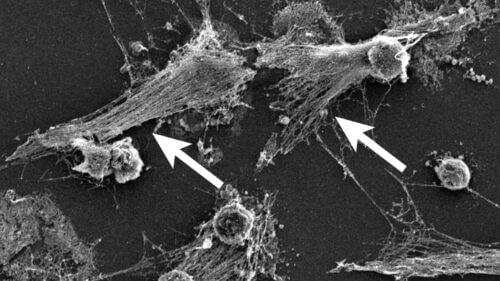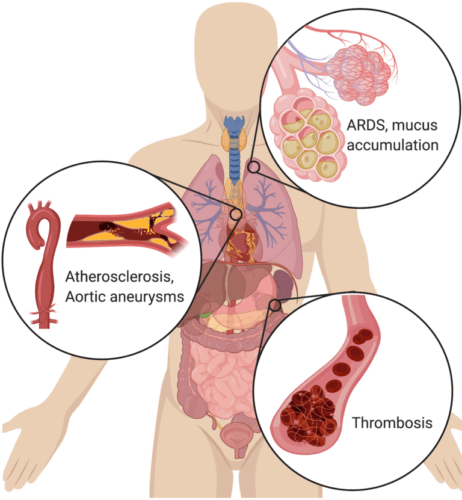New publications link the infiltration of neutrophils into patients' lungs and the symptoms of corona
By: Cold Spring Harbor Laboratories, translated by Ziv Adiki

New publications link the infiltration of neutrophils into patients' lungs and the symptoms of corona.
Amidst the panic to treat corona patients, a group of eleven international medical research organizations is investigating whether overactivity of the immune system cells, which produce neutrophil extracellular traps (NETs), is what causes the most severe cases of illness. The consortium, named the NETwork, includes, among others, Cold Spring Harbor Laboratories, the Feinstein Institute for Medical Research and the McGill University Health Center Research Institute.
The article, published on April 16, 2020, in the Journal of Experimental Medicine describes how patients with severe corona infection developed acute respiratory distress syndrome, pneumonia, thick sputum secretions in the respiratory tract, extensive lung damage and blood clots. This advanced state of the disease is difficult to control. In the most severe cases, patients are connected to artificial respiration, yet many of them die. The research group believes that the severity of the corona disease may be due to overactivity of the white blood cells, known as neutrophils. Being part of the body's immune system, neutrophils recognize bacteria and can remove their DNA to attack the bacteria using a fine mesh of DNA infected with toxic enzymes, called NETs. These traps can catch the unwanted pathogens (pathogens) and digest them, but in the case of acute respiratory distress syndrome, they damage the lungs and other organs.

"Given the clear similarity between the clinical manifestation of acute corona and that of other known diseases, which are caused by NETs, such as acute respiratory distress syndrome, we think that an excess of NETs plays a central role in the disease," says Dr. Betsy Barnes, lead and co-author of the article and researcher at the Feinstein Institute. "When samples from patients are accessible, it will be important to determine if the presence of NETs is related to the severity of the disease and if it is a unique clinical characteristic of the corona disease."
“NETs were identified in 2004, but many scientists had never heard of them. Most of the researchers in the NETwork group focused on the presence of NETs in other diseases, and when they started hearing about the symptoms of the corona patients, they sounded familiar to them," says Dr. Mikaela Egbeld, who formed the group of NETwork scientists around the study of the corona disease, Dr. Egbeld is a senior author and partner of the article.
Dr. Jonathan Spicer (MD, Ph.D.), a clinical scientist at the Feinstein Institute for Medical Research and the Research Institute of the McGill University Health Center and assistant professor of surgery at McGill University is a thoracic surgeon who has observed the devastating results of the corona virus infection in patients. "We see serious damage to the health of these patients, known as acute respiratory distress syndrome, this is another serious problem caused by the proliferation of NETs and which we also see in severe flu patients," he says. "Furthermore, their airways are often blocked with sputum, and unlike most severe cases of lung infections, these patients tend to develop small clots throughout their bodies at a much higher rate than usual. NETs have also been found in the blood of cancer patients and patients with sepsis (infectious shock), where they can promote the formation of such blood clots."
Researchers in this group are now examining whether NETs are a characteristic feature of corona patients. If their findings show that it is an excess of NETs that causes the acute symptoms of Corona, then a new direction of treatments that could help Corona patients may develop. Existing treatments, which are used in other diseases caused by NETs or neutrophils - such as cystic fibrosis, gout and rheumatoid arthritis - may suppress the activity of NETs in corona patients, thus reducing the need for artificial respiration.
to the article on the laboratory website
More of the topic in Hayadan:

2 תגובות
There is only one small problem with this model: usually a strong and aggressive immune system kills strong and young people during a severe viral attack. This is what happened with the swine flu, which for the population was a severe disease of a new virus, and therefore caused a strong reaction of the immune system, and most of the dead were between the ages of 30-50. For those aged 60 and over, the immune system cannot usually create a very aggressive reaction - the system weakens with age. In the new corona virus, most of the dead are adults. So there is a contradiction here to the argument of the article. Perhaps with more research it will be possible to explain in more detail and resolve the contradiction.
It has already been said about man that he is an example of a "whole that is greater than the sum of its parts" that is why we have intelligence, personality, soul, etc. The immune system behaves as if it is a police force with many groups of policemen, some of whom have a light hand on the trigger.. and now to the bottom line: is it possible that it may be present in corona, flu, Ebola, etc.. Negligible to allow the immune system to concentrate on it and when we will have a cure for most virus lesions. Who is willing to try it? In the hope that many will read and also translate into other languages